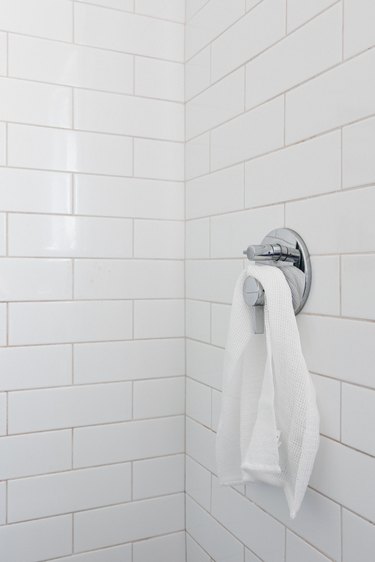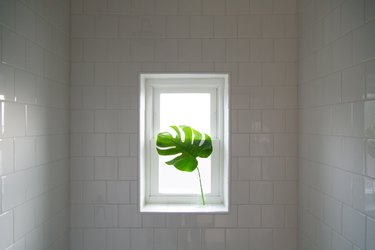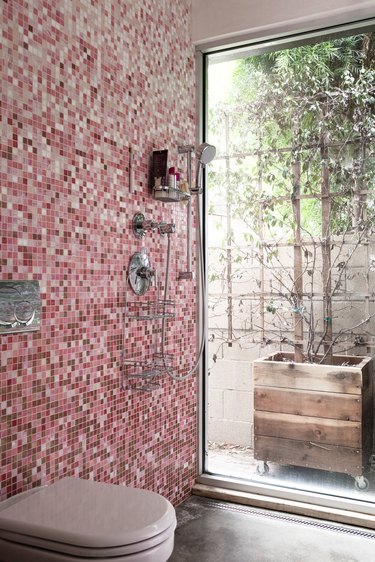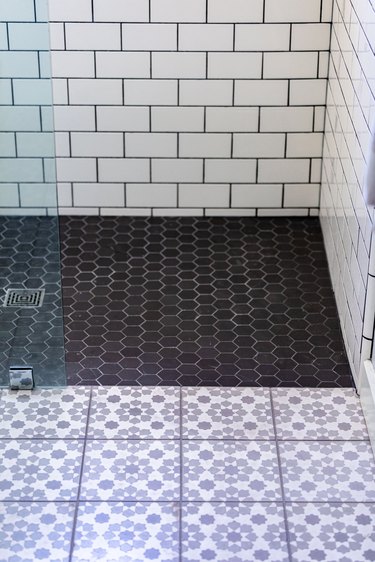Choosing the best tile for shower walls depends on a number of different factors. Appearance is one of the main selling points of tile, but it isn't the only thing that should be evaluated. Some other elements to consider include the size of the tile, its durability in a wet environment and how easy it is to work with. The tile rating may also weigh into the decision as well as the grout.
Selecting Tile Material for Shower Walls
Video of the Day
Natural stone, glazed porcelain and ceramic materials are some of the most popular when it comes to shower spaces — with each having their own unique features that make them stand out to homeowners. With that said, certain types of wall tile don't work as well in the shower. For example, metal tiles aren't good to use in damp or wet locations, and mosaic sheets create lots of grout lines, so it's usually best to use them sparingly or as a feature strip. Here are the main types of tile to which homeowners tend to gravitate for shower walls:
Video of the Day
Glazed ceramic tile: This type of ceramic tile is a great pick for homeowners who are looking for a tile that is easy to work with. Basic designs are among the most affordable tile picks, although some of the elaborate ones can get a bit more costly. Ceramic is also a durable tile, and the style and size choices are plentiful. It cuts easily but can be a little brittle, which means it can chip and/or break during installation without proper care.
The glazing on these ceramic tiles is a seal that helps keep out moisture, which is a great quality to have in terms of shower walls. This glaze makes the tile very low maintenance as well as scratch-resistant. It also seals any porous areas that may otherwise be prone to developing mold or mildew.
Glazed porcelain tile: According to the Tile Council of North America, glazed porcelain tiles have a water absorption rate of 0.5 percent or less, which makes them an outstanding material for shower walls. Much like ceramic tile, these tiles come in all kinds of colors, patterns and shapes, but they are an even harder and more durable material. They also tend to be more on the expensive side, but they have become very popular for use in the bathroom area.
Unlike ceramic tiles, glazed porcelain doesn't chip very easily. If by some chance it should, the color is baked all the way through the tile, so chips aren't very easy to see. The glazing on porcelain offers the same protection as it does on ceramic tile, making it a super pick for the shower. Also, porcelain is likely the best tile for a steam shower since it is the most dense material and retains heat better than natural stone.
Natural stone tile: The unique beauty of natural stone makes it a sought-after tile material, and it can look great on the walls in a shower space. Stone is hard and durable, but it is typically much more porous than the glazed surface of porcelain and ceramic tiles, requiring a bit more maintenance and care. This can be especially true for some of the lighter-colored stones, although that isn't a hard and fast rule. Even with all those caveats, stone is one of the high-end tile choices that people like to see in a home.
Some natural stones work better than others in a bathroom shower, so keep that in mind when weighing advantages and disadvantages in terms of materials. For wet locations, the Natural Stone Institute points out that materials such as granite and marble should be treated with a sealer to address the fact that they are more porous than glazed ceramic tile and porcelain. Travertine is another type of natural stone that can be used for shower walls. It must also be sealed to protect against moisture.
Consider the Tile Size
The size of the bathroom will help dictate the size of the tile selected. The individual homeowner's taste as well as the budget and the latest trends also factor into the decision. Browse at tile stores or online to get a sense of the current looks and start to dial in preferences. Some people love the look of simple white subway tile, while others may embrace a large-format tile with patterns. There's a lot to view, and the size and configuration of the bathroom should also be taken into account when deciding.
While there are no hard and fast rules, some of the common tile sizes available are also among the most popular, including 12 x 12, 16 x 16 and 12 x 24. Subway tiles at 3 x 6 are also widely used. American Olean suggests using large tiles to make a room feel bigger and small tiles to create a streamlined appearance. If it's going to be a DIY job, that will be something to weigh as well. Although large-format tiles are popular, they can be difficult to manage, especially when installing them on a wall. Small tiles require more cutting and/or grouting.
Adventurous DIY fans may want to experiment with different layouts to add interest as well. For example, smaller subway tiles can be laid in a running bond, offset, herringbone or diagonal pattern; there are many choices. Square tiles can be rotated to create a diamond shape. Mosaic tile or smaller tiles can be included as a feature strip or even a feature wall. There are many options for using layout to make the design more appealing. Just remember to add some extra planning time.
With a tile floor, it's easy to do a mockup of the layout, but this isn't as simple on the walls of a shower. Be sure to take careful measurements and remember that there are several walls to consider, and they are typically interconnected. Also be sure to take into account any built-in design features, such as a shower niche that might be tricky to execute with a particular type of tile. Considering the size and layout before buying a particular shower tile will help in choosing the material that will work best in the area.
Investigate Tile Ratings
Strength and durability tile ratings were created to reflect the suitability for a particular tile's use in different areas. They are based on a scale developed by the Porcelain Enamel Institute. This scale reflects the overall durability of the particular tile, and it is based on a number system that ranges from one to five, with one being the lowest durability rating and five being the highest durability rating.
While this number is generally more important for flooring than shower walls, it may still factor into the overall decision-making process. For example, consider the traffic in the bathroom. Is this a master bathroom shower that will be used daily? Is it a guest bath that sits empty unless there is company? A rating of three is generally recommended for light to moderate traffic, while a rating of two is recommended for lighter traffic areas.
Color variance is another factor that has a rating system, this one developed by the Ceramic Tile Distributors Association. It was created to help describe the variability in color and shade in ceramic and porcelain tile. The ratings are separated into V1, V2, V3 and V4 categories, with the lowest number having the least amount of variability and the highest the most. If this number is available, it can be helpful. Natural stone is variable by nature, which is part of its appeal, so it doesn't have a V-scale rating.
Test Out the Tile in the Space
There's nothing quite like seeing a tile in the room where it will be installed to help with making a decision. It's one thing to pick something out at the store or online but quite another to see it in the actual shower space. It helps to see how the size of the tile works as well as how the colors are reflected and if they are going to be a match for the color palette under the lighting fixtures or with the sun shining in. This is an important step with paint, and it works with tile as well.
This may not be as much of an issue with plain tiles or white tile, but colors and patterns can feel very different from one room to the next. The cost of purchasing a few sample tiles is well worth the investment to make sure the tile is a good mix with the overall design concept. Be sure to check out how the tiles look in both the daytime and at night and with all the combinations of lighting in the room if possible to get the best tile match.
The color and texture of the tile is another factor to evaluate. General design rules state that lighter colors can make a space feel larger, while darker ones may make it seem smaller. This can be an especially important factor in a bathroom, as they aren't usually among the largest rooms in the house. In addition, textured tiles, such as those with a wood look, may not be as easy to clean in the shower area, where moisture creates mildew and buildup fairly rapidly.
Don't Forget the Grout
While grout isn't something that springs to mind when choosing a tile for the bathroom, it should definitely be a consideration because it is something that needs regular maintenance. While the glazing on porcelain and ceramic tiles keeps things pretty simple to maintain, grout adds a complicating factor. Mold, mildew, grime and soap scum like to accumulate in grout lines, and this is especially true in a moist environment like a shower.
Those considering a DIY job will really want to think through the grout line sizes when choosing a bathroom wall tile. Typically, wider grout lines are easier to do in terms of spacing tiles and making things look good, but that also creates more grout surface area, which means more space that needs to be cleaned and maintained. That said, smaller grout lines result in less grout surface area but are more challenging to pull off. Take a look at the overall picture — tile size, skill at installation and grout lines — before making a final choice.
Although there are no universal rules for grout line sizes, commonly used spacing sizes include 1/16, 1/8 and 3/16. Smaller-size grout lines become very difficult, while larger tile (bigger than 3/16) can start to look unappealing. Also, don't forget to think through the color of the grout when choosing tile. A grout in a similar color will create a seamless appearance, blending tiles together, while a contrasting color will make individual tiles pop. Keep in mind the fact that lighter grout shows mold, mildew and grime more easily.
- Tile Council of North America: Cleaning Grout
- Tile Council of North America: Glaze Resistance
- Tile Council of North America: Installing Tile
- Tile Council of North America: Showers & Steam Rooms
- Ceramic Tile Education Foundation: Getting the Coverage You Need Under Large Wall Tile
- Natural Stone Institute: Singing the Praises of Natural Stone in the Shower
- Mr. Steam: Tile Steam Shower? Marble Steam Shower? What's the Difference?
- American Olean: 4 Tips for Using Tile Sizes to Your Advantage
- Ceramic Tile Distributors Association: Color/Shade Variation Program



